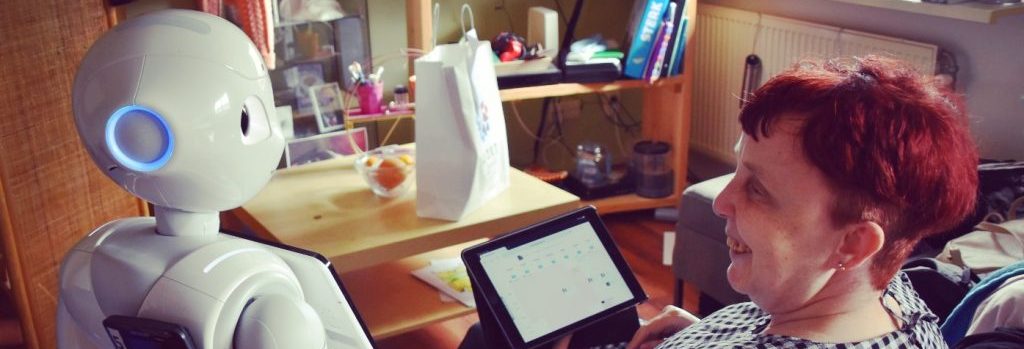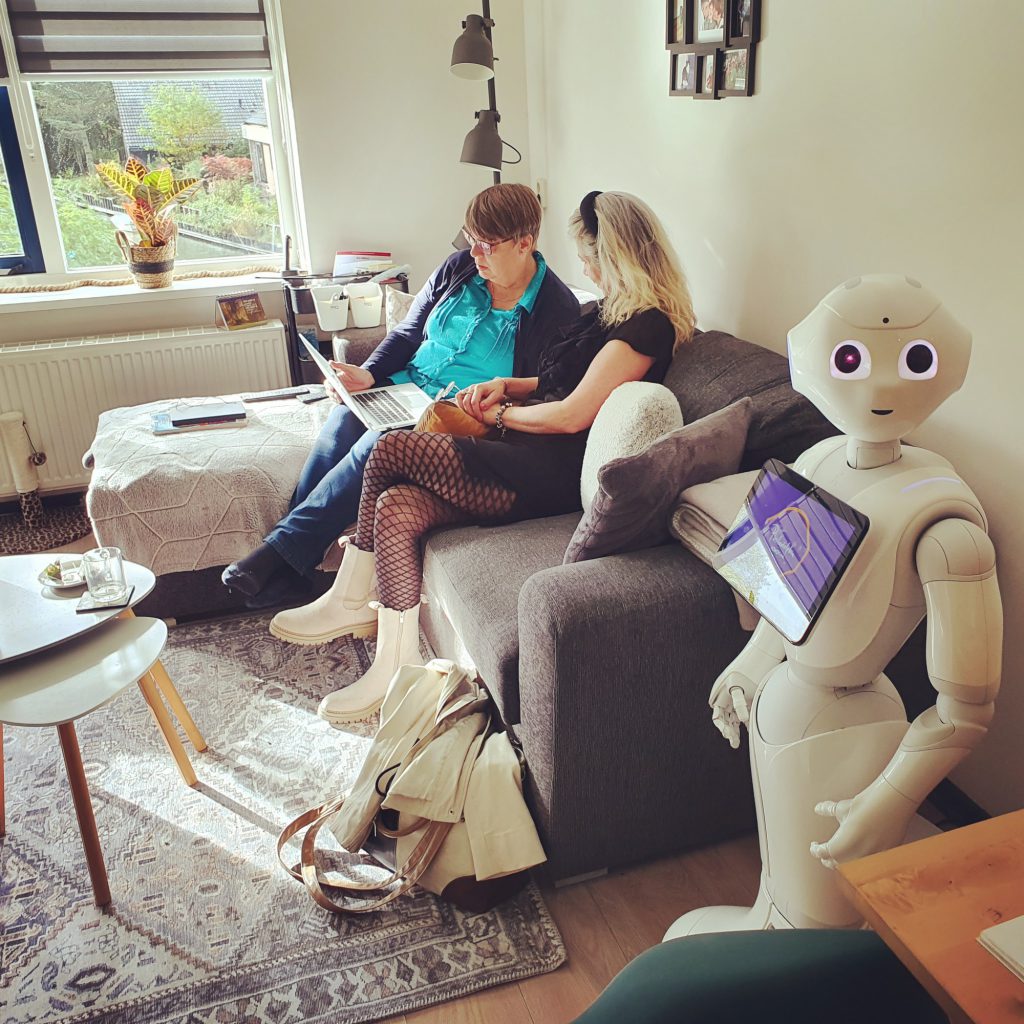
Philadelphia: Alignment is all about the process
Innovation and digitization are constantly developing and thus becoming an increasingly important part of healthcare. For example, innovations offer solutions for the enormous staff shortage that the healthcare sector has been dealing with.
Another example is healthcare provider, Philadelphia, currently deploying six robots to be part of their healthcare team’s permanent staff. The robots are programmed to engage in social interactions and to support clients with learning disabilities in their daily lives. This is not only fun for the clients but the robots also take over a lot of the floor supervisors’ tasks. We spoke with Xenia Kuiper, Program Manager Social Robotics at Philadelphia, about the role of alignment in developing new digital innovations in the healthcare process.
Social robots
Since 2016, Kuiper and her team have been developing Social Robots in collaboration with The Innovation Playground. Kuiper’s robotics team and Social Robotics program focus on two things: research & observation and development & innovation. Based on this research and their observations, they develop the software together with a third partner. They used their conversations with clients to put together a personal interaction program so that the robot arrives at the homes fully configured and ready to care. “In the future, the robot should really be able to take over part of the daily tasks of healthcare professionals,” Kuiper explains. This will help to increase their clients’ self-reliance and also offers a partial solution to future labor problems. The team works remotely and uses dashboards to monitor the robots’ field observations and data. This allows them to, for example, specifically monitor the robots as they’re completing their tasks and during their interactions with clients, and use this data to guide clients and healthcare professionals, and/or to identify and resolve any technical problems.
Off the beaten track
Innovation is part of Philadelphia’s DNA. They are always looking for new developments, but as a result are sometimes too focused on the start of a project, which takes attention away from making sure they’ll get where they need to go. This has pros and cons and even an element that is both a pro and a con: the lack of a fixed process. The downside to this is that everything you do is an experiment. On the other hand, Kuiper has the opportunity to carry out this project on the fringes of the existing organization: “We are exploring something that doesn’t exist yet, so we sometimes go off the beaten track.
It helps that we got the mandate from the board, offering us a promising position for successful innovation.” Kuiper hopes that the Social Robotics project can serve as an example for tackling future innovation projects. Right now, Philadelphia is conducting multiple digital projects. “We’re now at a tipping point where we’re looking at how these projects, which are very successful in their own right, can be linked together strategically,” she explains. For example, there are “digital-human” projects, data- driven care projects and even smart incontinence materials that all collect interesting data that can be relevant to multiple departments. It’s paramount that these different initiatives and projects are aligned with each other and with the organization as a whole so that everything fits together well once the innovations are added to the suite of care services.
The whole pizza
When Kuiper thinks of alignment, it always fuels her inner business-administration fire: “I always try to use the program to demonstrate which main themes within the organization we’re touching upon. The program describes the most important themes that ensure that you can ultimately deploy a well-functioning robot as part of day-to-day care and suite of services.” She uses the education theme as an example. Educational training should ensure that the staff knows how to work together with the robot.
Kuiper has a multi-year plan, in which she divided the alignment theme into seven slices. For each slice, she has created a roadmap on her goals in terms of what she wants to achieve on, for example, client level, organizational level, and employee level. Kuiper calls this a pizza: ”You can only succeed if all the slices of the pizza are accounted for.” During the process, she tries to set clear priorities. For example, she made the conscious decision to not immediately start working on a business case at the start of the project, but to build it up as she goes. “Initially, building a business case was placed at the bottom of our list, so that we could first determine what a robot actually has to be able to do to add value to the existing healthcare programs. You can only investigate and experiment with a working robot, after all,” she states.
In order to test her program with the Board of Directors, she made an outline of the most important themes, based on the Past-Present-Future maturity model. First, she checked with the board whether or not her plan was aligned with the company’s vision for the future. From there, she can fine-tune her plan and then involve her team and, ultimately, the rest of the organization.
Try it out
With a plan in place and a functioning robot, it’s time for the implementation phase. But where do you start? As far as Kuiper is concerned, you just have to start somewhere and try it out. “Philadelphia bought a robot and made sure it was able to recognize humans. Then, we invited a few parents, a behavioral expert, someone from the board, and some people from direct care to experience and work with it,” she explains. Currently, there are six robots deployed 24/7. The feedback and experiences these robots collect provide an enormous collection of data that Kuiper and her team use to improve the robot further. Philadelphia doesn’t only use the robots to develop digital solutions, but also to create support within the organization. For example, the robot sometimes ‘sleeps over with one of its colleagues from care or management.
The Social Robotics program is a unique project, partly because of the scale at which data is collected. Kuiper: “The entire Robotics program runs on continuous data analysis.” So how do you ensure that all this data is aligned? According to Kuiper, this is a “new chapter” for this healthcare organization. It’s quite challenging to collect data in healthcare because you have to take so many different factors into account, like privacy. At the moment, they are still processing all this data manually, but they won’t have to for much longer: “We now have to take the step towards AI. We figured out how to make a good interaction program and now we have to teach those rules to AI.”
Transparency
Of course, it’s the plan that the robots will soon be deployed on a large scale and actively participate in the primary care process. In order to bring these processes together, you have to look at how the Robotics program fits into Philadelphia’s complete care package. This piece of alignment is only now getting its well-deserved spotlight. Kuiper suspects that this has to do with the fact that “other parts of the organization are more open to this project and that the Social Robotics project has already proven itself.” It doesn’t matter how you look at it, these robots are here to stay, so, according to Kuiper, now is time to start working together integrally: “For now I strongly believe in the power of connections, the relationships between all moving parts and ensuring that you make clear decisions about that in the organization. Working together and communicating with other teams is an important part of this: we have used the word ‘transparency’ for years. The teams meet regularly to give each other a look behind the scenes. They then work together on connecting the projects to Philadelphia’s ‘why’ and how they relate to the other projects.”
In the thick of it
For Kuiper, the alignment theme is at the top of her list: “Alignment should be a separate theme within your project plan,” she states. As a result, she estimates that it takes up about 90% of her time, mostly within her own team. It takes one heck of a leader to align a team of twelve people who all work remotely. But Kuiper has a tip for other people in her position: “Don’t be afraid to really lead your team and to get in the thick of it. You’ll see the rest will follow suit.”
